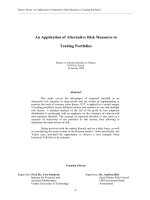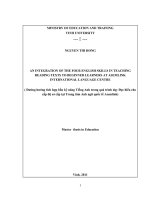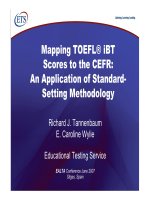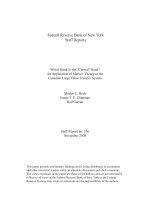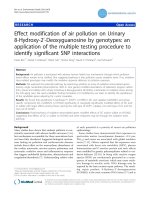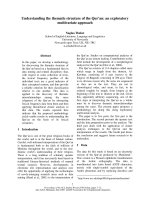An application of the thematic structure progression to enhance coherence in writing for in service english majored sciences and humanities in ho chi minh city m a 60 14 10
Bạn đang xem bản rút gọn của tài liệu. Xem và tải ngay bản đầy đủ của tài liệu tại đây (1.15 MB, 177 trang )
VIETNAM NATIONAL UNIVERSITY - HO CHI MINH CITY
UNIVERSITY OF SOCIAL SCIENCES & HUMANITIES
DEPARTMENT OF ENGLISH LINGUISTICS & LITERATURE
AN APPLICATION OF THE THEMATIC STRUCTURE
PROGRESSION TO ENHANCE COHERENCE IN
WRITING FOR IN-SERVICE ENGLISH MAJORED
FRESHMEN AT THE UNIVERSITY OF SOCIAL
SCIENCES AND HUMANITIES
IN HO CHI MINH CITY
Submitted to the
Department of English Linguistics and Literature
in partial fulfillment of the Master’s degree in TESOL
By
VƯU TIẾN VĨ
Supervised by
NGUYỄN HOÀNG TUẤN, PHD
HO CHI MINH CITY, MAY 2013
STATEMENT OF AUTHORITY
I hereby certify my authorship of the thesis submitted today entitled
AN APPLICATION OF THE THEMATIC STRUCTURE
PROGRESSION TO ENHANCE COHERENCE IN WRITING FOR INSERVICE ENGLISH MAJORED FRESHMEN AT THE UNIVERSITY
OF SOCIAL SCIENCES AND HUMANITIES IN HO CHI MINH CITY
in terms of the Statements of Requirements for Theses in Master’s
Programs issued by the Higher Degree Committee.
This thesis has not previously been submitted for the award of any
degree or diploma in any other institution.
Ho Chi Minh City, April 20th, 2013
VUU TIEN VI
i
RETENSION AND USE OF THE THESIS
I hereby state that I, VƯU TIẾN VĨ, being the candidate for the degree
of Master of TESOL, accept the requirements of the University relating to the
retention and use of Master’s Theses deposited in the Library.
In terms of these conditions, I agree that the original of my thesis
deposited in the library should be accessible for purposes of study and
research, in accordance with the normal conditions established by the Library
for care, loan or reproduction of theses.
Ho Chi Minh City, April 20th, 2013
VƯU TIẾN VĨ
ii
ACKNOWLEDGE
I wish to acknowledge my deepest gratitude to my thesis supervisor Dr.
Nguyen Hoang Tuan. Without his patient guidance and constant
encouragement, my thesis would not have been consummated on time. Along
the odyssey of the completion of the work, his willingness to discuss the
concerned issues shed light of hopes unto the route on which I make every
effort to advance. Furthermore, I am greatly indebted to his generosity and
kindness. He often offered me valuable feedback, line-by-line comments,
insightful discussion and constructive criticisms from the preliminary draft to
the completed work. Without his insightful suggestions, the thesis would be
far from completed.
I would like to thank all the lecturers of the TESOL graduate program at
the University of Social Sciences and Humanities for their dedication and
helpful instruction during the course.
I would also like to express my warmest gratitude and appreciation to the
first-year English majored students at the University of Social Sciences and
Humanities who actively participate in the pilot study in attempts to test the
validity of thematic progression in students’ writing. Without their
participation, the final results of the thesis may not have been satisfactory.
Last but not least, my wholehearted gratitude also goes to my beloved
family who encouraged, supported tremendously in the completion of the
study.
iii
ABSTRACT
Among four skills, writing is considered one of the most difficult skills.
Previous research on EFL and ESL learners’ writing has revealed that some
advanced language learners may have difficulties in creating a well-organized
writing paper. Among all criteria to assess a good writing, coherence is claimed
to be the most abstract but essential, whose subcomponents and characteristics
are difficult to analyze and describe since many learners, even with a good
command of grammatical knowledge, still lack the ability to compose wellorganized essays. They have deficiency in the knowledge of coherence and
display limited ability to write effectively and successfully. Therefore, it drives
the researchers the imperative need to uncover a heuristic tool which could help
our learners handle coherence problems such as cohesive devices,
conjunction… However, few of them have been examined empirically on their
effects so far. The study aims to investigate effectiveness of thematic structure
progression in improving the students’ writing for English majored freshmen at
the University of Social Sciences and Humanities in Ho Chi Minh City.
Students’ essays before and after the revision were rated and compared to see
which group gain more score in general writing quality as well as in
coherence after the revision. The experimental group’s essays were analyzed
additionally to examine whether they improve coherence and whether they
develop their ideas in a more logical way. In addition, the group was required
to apply the strategy to their next assignment and it was compared with the
first essay written at the beginning of the study, which aimed to examine if
our previous instruction was sufficient for the students to apply the strategy
independently. Besides students’ essays, questionnaires were distributed to
survey students’ perspectives on the revising strategy and whether it promoted
their awareness of their own idea progressions and of the elements of textual
coherence.
iv
The results demonstrated that the experimental group not only improved the
general impression of unity, but also achieved better performance in the
coherence internal to each paragraph than their peers in control group. They
became clearer about the paragraph main idea they intended to convey, and
were better able to modify ill-developed supporting ideas by further providing
necessary information to complete the development. Furthermore, some
ambiguously- connected ideas were pinpointed and the gaps among their
meaningful relations were bridged by giving transitional sentences. These
improvements were reflected in the different patterns of thematic progressions
in students’ two versions of writing. In addition, the questionnaire response
also revealed students’ general positive perception of the strategy. Most
students agreed that thematic progression helped them to be better aware of the
coherence in their writing and that it gave them a tangible way for self-revision
in which they can approach the coherence problem level by level. The followup interviews showed the somewhat different opinions on the technique held
by writers of different writing proficiency.
On the grounds of the findings, some recommendations are made to the
students, the teachers, the syllabus on teaching and learning writing as well as
the teaching methods of writing to improve the students’ coherence in their
writing paper.
v
TABLE OF CONTENTS
Page No.
Certificate of originality ...................................................................................... i
Retention and use of the thesis ........................................................................... ii
Acknowledgement ............................................................................................ iii
Abstract ............................................................................................................ iv
Table of contents .............................................................................................. vi
List of tables ....................................................................................................xiii
List of charts ................................................................................................... xvi
List of diagrams and figures .......................................................................... xvii
Abbreviations ............................................................................................... xviii
Chapter 1
INTRODUCTION
1.1 Rationale to the study ................................................................................... 1
1.2 Background to the study ............................................................................... 2
1.3 Purpose of the study ..................................................................................... 3
1.4 Significance of the study ............................................................................... 4
1.5 Limitation of the study................................................................................... 4
1.6 Organization of the study............................................................................... 5
Chapter 2
LITERATURE REVIEW
2.1 Thematic progression..................................................................................... 6
2.1.1 Simple linear thematic progression ............................................................ 7
2.1.2 Thematic progression with continuous/ constant theme............................... 8
2.1.3 Thematic progression with derived theme .................................................. 8
2.2 Coherence in writing ................................................................................... 10
2.3 Types of coherence in writing ..................................................................... 12
vi
2.4 Coherence and cohesion ............................................................................. 12
2.5 Rhetorical pattern in English written discourse ........................................... 14
2.6 Metafunction of language .......................................................................... 16
2.6.1 Experiential/Ideational Meanings ......................................................... 16
2.6.1.1 Material process ............................................................................. 16
2.6.1.2 Behavioural process ....................................................................... 16
2.6.1.3 Mental process ............................................................................... 17
2.6.1.4 Verbal process................................................................................ 17
2.6.1.5 Relational process .......................................................................... 17
2.6.1.6 Existential process.......................................................................... 18
2.6.2 Interpersonal Meanings ....................................................................... 18
2.6.3 Textual Meanings ................................................................................ 18
2.7 Theme and Rheme ...................................................................................... 19
2.7.1 Theme................................................................................................... 19
2.7.2 Rheme .................................................................................................. 19
2.7.3 Classification of theme .......................................................................... 20
2.7.3.1 With regard to its complexity ........................................................... 20
2.7.3.1.1 Single theme ............................................................................... 20
2.7.3.1.2 Re-entry theme (multi-theme) ..................................................... 20
2.7.3.1.3 Sentence entry theme (sentence theme) ....................................... 20
2.7.3.2 With regard to its meta-function ....................................................... 21
2.7.3.2.1 Topical theme .............................................................................. 21
2.7.3.2.2 Interpersonal theme ...................................................................... 21
2.7.3.2.3 Textual theme ............................................................................. 22
2.7.3.3 With regard to its position ................................................................ 23
2.7.3.3.1 Unmarked theme................................................................................ 23
vii
2.7.3.3.2 The marked theme ............................................................................. 24
2.7.3.4 With regard to its function in a paragraph .............................................. 24
2.7.3.4.1 Hypertheme ....................................................................................... 24
2.7.3.4.2 Hypernew ........................................................................................... 24
2.7.3.4.3 Macrotheme ....................................................................................... 25
2.4 Summary ..................................................................................................... 27
Chapter 3
RESEARCH METHODOLOGY
3.1 Research questions ...................................................................................... 28
3.2 Research design .......................................................................................... 29
3.3 Participants .................................................................................................. 30
3.3.1 The teacher subjects ............................................................................... 30
3.3.2 The student subjects ............................................................................... 30
3.3.3 The raters ............................................................................................... 30
3.3.4 The researcher ....................................................................................... 31
3.4 Instruments and materials ........................................................................... 31
3.4.1 Instruments ............................................................................................ 31
3.4.1.1 The experimental teaching ................................................................ 32
3.4.1.2 The tests............................................................................................ 32
3.4.1.3 The questionnaires ............................................................................ 32
3.4.1.3.1 The teachers’ questionnaires ........................................................ 32
3.4.1.3.2 The students’ questionnaires ........................................................ 33
3.4.1.4 Class observations............................................................................ 33
3.4.1.5 Interviews ........................................................................................ 34
3.4.1.6 Procedure of doing research ........................................................... 34
3.5 Data analyzing method ................................................................................ 36
3.6 Data collection procedure ............................................................................ 36
viii
3.6 Stages in writing teaching for experimental group …………………………37
3.6.1 Pre-writing stage ................................................................................... 39
3.6.2 While-writing stage................................................................................ 40
3.6.3 Revision stage....................................................................................... 40
3.7 Summary ..................................................................................................... 42
Chapter 4
DATA ANALYSIS AND FINDINGS
4.1 Responses to the questionnaires ................................................................... 43
4.1.1 Responses to the students’ questionnaires .............................................. 43
4.1.1.1 Responses for background information ............................................ 43
4.1.1.1.1 Students’ years of age .................................................................. 43
4.1.1.1.2 Students’ gender.......................................................................... 44
4.1.1.1.3 Where the students studied before entering the USSH ................. 44
4.1.1.1.4 The time the students studied English as a foreign language ........ 45
4.1.1.1.5 Students’ participation in extra-curricular writing activities.......... 46
4.1.1.2 Data on participants’ viewpoints on writing ...................................... 46
4.1.1.2.1 Role of writing in language acquisition ........................................ 46
4.1.1.2.2 Students’ opinions on learning writing ........................................ 47
4.1.1.2.3 Students’ self-evaluation of their writing skill .............................. 48
4.1.1.2.4 Summary....................................................................................... 49
4.1.1.3 Responses for the learning of writing and knowledge of thematic structure
4.1.1.3.1 Students’ strategies of writing ...................................................... 49
4.1.1.3.2 The difficulties that students may face in writing ......................... 50
4.1.1.3.3 Students’ knowledge of thematic progression................................ 51
4.1.1.4 Responses for students’ attitude towards the roles of thematic progression
......................................................................................................................... 52
4.1.1.5 Summary ............................................................................................. 53
ix
4.1.2 Responses to teachers’ questionnaire ........................................................ 53
4.1.2.1 Responses for teachers’ background information ................................ 53
4.1.2.2 Responses for teachers’ responses to the criteria in assessing the students’
writing .............................................................................................................. 54
4.1.2.3 Teachers’ opinions on teaching writing .............................................. 55
4.1.2.4 Teachers’ opinions on coherence in writing ....................................... 56
4.1.2.5 Teachers’ opinions on the role thematic structure progression in improving
the students’ coherence in writing ..................................................................... 57
4.1.2.6 Summary ............................................................................................ 57
4.2 The results of the two tests........................................................................... 58
4.2.1 The comparison of overall writing scores................................................. 58
4.2.1.1 The pre-test scores ............................................................................... 58
4.2.1.2 The post-test scores............................................................................. 60
4.2.1.3 Difference in the two groups’ pre-test and post-test scores ................... 61
4.2.1.4 Classification of pre-test and post-test of two groups ........................... 62
4.2.1.5 Comparison of range of difference between pretest and posttest of the
control-group and the experimental group ........................................................ 65
4.2.2 Comparison of coherence scores .............................................................. 67
4.3 Qualitative analysis of students’ samples (using thematic structure progression)
......................................................................................................................... 70
4.4 The results of the interview.......................................................................... 81
4.4.1 The students’ perception of thematic structure ........................................ 81
4.4.2 The students’ attitude towards the effect of thematic structure ................ 84
4.4.3 Students’ difficulties in perceiving thematic structure ............................. 86
4.5 Summary of the findings.............................................................................. 88
x
Chapter 5
CONCLUSION AND IMPLICATIONS
5.1 Summary of findings ................................................................................... 91
5.2 Recommendations ....................................................................................... 93
5.2.1 To the teachers....................................................................................... 93
5.2.2 To the students....................................................................................... 94
5.2.3 The syllabus and the coursebook ............................................................ 95
5.3 Stages of teaching writing with thematic structure ....................................... 95
5.3.1 Pre-teaching writing ............................................................................... 95
5.3.1.1 Brainstorming ................................................................................... 95
5.3.1.2 Identifying context of situation and culture ....................................... 95
5.3.1.3 Getting acquaintance with thematic development .............................. 96
5.3.2 While-teaching writing .......................................................................... 96
5.3.2.1 Write the first draft............................................................................ 96
5.3.2.2 Revise for coherence ......................................................................... 96
5.3.2.3 Revise for cohesion ........................................................................... 97
5.3.3 Editing ................................................................................................ 101
5.4 Suggestions for future research .................................................................. 101
5.5 Conclusion ................................................................................................ 102
BIBLIOGRAPHY ......................................................................................... 103
APPENDICES ............................................................................................... 108
APPENDIX 1:
STUDENT SAMPLES .............................................. 108
APPENDIX 2:
QUESTIONNAIRE FOR TEACHER ......................... 111
APPENDIX 3:
QUESTIONNAIRE FOR STUDENTS
(BEFORE EXPERIMENTAL TEACHING) .............. 113
APPENDIX 4:
QUESTIONNAIRE FOR STUDENTS
(VIETNAMESE VERSION) ........................................ 115
xi
APPENDIX 5:
QUESTIONNAIRE FOR STUDENTS
(AFTER EXPERIMENTAL TEACHING) ................ 117
APPENDIX 6:
QUESTIONNAIRE FOR STUDENTS
(VIETNAMESE VERSION) ........................................ 119
APPENDIX 7:
STUDENTS’ INTERVIEW QUESTIONNAIRE ....... 121
APPENDIX 8:
CLASSROOM OBSERVATION REPORT ............... 122
APPENDIX 8A: CLASSROOM OBSERVATION REPORT 1 ............. 122
APPENDIX 8B: CLASSROOM OBSERVATION REPORT 2 ............. 125
APPENDIX 8C: CLASSROOM OBSERVATION REPORT 3 ............. 128
APPENDIX 9:
JACOB’S SCORING RATE (2010) ........................... 131
APPENDIX 10:
LESSON PLAN 1........................................................ 134
APPENDIX 11:
LESSON PLAN 2........................................................ 137
APPENDIX 12:
LESSON PLAN 3........................................................ 139
APPENDIX 13:
LESSON PLAN 4........................................................ 141
APPENDIX 14:
LESSON PLAN 5........................................................ 144
APPENDIX 15:
LESSON PLAN 6........................................................ 146
APPENDIX 16:
LESSON PLAN 7........................................................ 149
APPENDIX 17:
LESSON PLAN 8........................................................ 152
APPENDIX 18:
OVERALL WRITING PROFICIENCY SCORES
OF THE CONTROL GROUP AND THE EXPERIMENTAL
GROUP ....................................................................... 154
APPENDIX 13:
COHERENCE SCORES OF THE CONTROL GROUP AND
THE EXPERIMENTAL GROUP ................................ 156
APPENDIX 14:
POST-TEST ................................................................ 158
xii
LIST OF TABLES
Table 2.1
Cohesive devices (Nunan, 1999: 19)
Table 2.2:
Example of Material Process (Halliday, 1994)
Table 2.3:
Example of Behavioural Process (Halliday, 1994)
Table 2.4:
Example of Mental Process (Halliday, 1994)
Table 2.5:
Example of Verbal Process (Halliday, 1994)
Table 2.6:
Example of Identifying Process (Halliday, 1994)
Table 2.7:
Example of Attributive Process (Halliday, 1994)
Table 2.8:
Example of Existential Process (Halliday, 1994)
Table 2.9:
Example of Interpersonal Theme (Halliday, 1994:49)
Table 2.10
Structural adjunct (Halliday 1994:50)
Table 2.11
Conjunctive adjunct (Halliday 1994:50)
Table 2.12
Marked Theme
Table 3.1
The r-value for the pretest and post-test
Table 3.2
Process of research implementation
Table 3.3
The syllabus for the entire curriculum
Table 4.1
Students’ years of age
xiii
Table 4.2
The division of the two sexes
Table 4.3
Students’ years of learning English as a foreign language
Table 4.4
The
students’ participation
in
extra-curricular
writing
activities
Table 4.5
Students' opinions on learning writing skill
Table 4.6
Students' self-evaluation of their writing skill
Table 4.7
What do you focus on when you write?
Table 4.8
The difficulties that students may face in writing
Table 4.9
Have you ever learned thematic structure progression before?
Table 4.10
Teachers’ teaching experience
Table 4.11
Teachers’ duration of teaching writing
Table 4.12
The degree currently held by teachers
Table 4.13
Teachers’ opinions in teaching writing
Table 4.14
Teacher’s opinion on the importance of coherence in writing
Table 4.15
Teachers’ opinion the role of thematic structure progression in
improving learners’ speaking skills
Table 4.16
The control group’s and the experimental group’s pre- test
scores
Table 4.17
Comparison of the two groups’ pretest scores
xiv
Table 4.18
Comparison of the two groups’ post- test scores
Table 4.19
The control group’s and the experimental group’s post- test
scores
Table 4.20
Comparison of the pre-test and post-test scores within each of
the two groups
Table 4.21
Comparison of the two groups’ first-semester and secondsemester test scores
Table 4.22
Classification of the two groups’ pre-test and post-test scores
Table 4.23
The Improvement Ranges of Coherence
Table 4.24
Comparison of the Distributions of improvement range of the
control group and experimental group
Table 4.25
Comparison of means in coherence scores of experimental
group before and after the treatment
Table 4.26
The distribution of improvement ranges of coherence scores in
the control group and experimental group after the treatment
Table 4.27
The aspect that the students benefit the most from the
curriculum
Table 4.28
The students’ attitude towards the effect of thematic structure
xv
LIST OF CHARTS
Chart 4.1
Places where the students studied before entering USSH
Chart 4.2
Writing’s importance in language teaching and learning
Chart 4.3
What you focus when you write
Chart 4.4
The difficulties that students may face in writing
Chart 4.5
Students’ responses to the statement “learning thematic
structure progression plays an essential role in improving
coherence in their writing”
Chart 4.6.
The score of control group in pre-test and post-test
Chart 4.7
The score of experimental group in pre-test and post-test
xvi
LIST OF DIAGRAMS AND FIGURES
Diagram 2.1
Thematic system (Thompson, 2004, p.164)
Diagram 4.1
Thematic progression of writing draft of the student 1
Diagram 4.2
Thematic progression of writing revision of the student 1
Diagram 4.3
Thematic progression of writing draft of the student 2
Diagram 4.4
Thematic progression of writing revision of the student 2
Diagram 4.5
Thematic progression of writing draft of the student 3
Diagram 4.6
Thematic progression of writing revision of the student 3
Figure 2.1
Danes’s Simple Linear Thematic progression
Figure 2.2
Danes’s Thematic progression with continuous/ constant
theme
Figure 2.3
Danes’s Thematic progression with derived Theme
Figure 2.4
Danes’s Thematic progression with derived Rheme
Figure 4.1
Jacobs’ scoring profile
Figure 5.1
Strategies of writing outside the text
Figure 5.2
Strategies of writing within the text
xvii
ABBREVIATIONS
CD
:
Communicative Dynamism
EFL
:
English as a Foreign Language
ESL
:
English as a Second Language
FFL
:
Faculty for Foreign Languages
FSP
:
Functional Sentence Perspective
L1
:
The first language
L2
:
The second language
SPSS
:
Statistics Package for Social Sciences
TESOL :
Teaching English to Speakers of Other Languages
USSH
University of Social Sciences and Humanities
:
xviii
CHAPTER I
INTRODUCTION TO THE STUDY
The chapter begins with the rationale of the study. Then comes a background to the
teaching of English writing at university in Vietnam. Last comes the aim and the
significance of the study, along with limitations which are to supply background
information for this study at university in Vietnam nowadays.
1.1 Rationale to the study
English writing skill is a nightmare for most freshmen at university. Most of the
students even with a good command of grammatical knowledge still lack the ability
to compose a fluent and well-organized essay. In the meantime, teachers also find it
hard to assist students in producing pieces of quality academic writing (Synanondh
& Padgate, 2005). Many instructors as well as students believe that it is because of
students’ vocabulary deficiency and incapability of writing “perfect and
complicated” sentences. Under such an assumption, writing classes have been drills
of sentence patterns, substitutions, completion or imitation of sentences and so on
(Myles, 2002). It means that a full essay becomes just a collection of various
sentence patterns and sophisticated vocabulary items. Though grammatical accuracy
and vocabulary appropriateness are surely a part of a well-written composition,
there is something more important and easier to command - discourse structure,
which is mostly ignored.
As a lecturer of the University of Social Sciences and Humanities, I have taught
English writing for English majored in-sevice students for a long time. During my
teaching at this university, I have observed that many students face numerous
difficulties in learning writing. They have no idea of how to write a well-organized
English composition. What they can do is just write down anything that comes to
their minds. As a result, their compositions are just unrelated sentences or fragments
put together, which make the writing incoherent.
The underlying reason of these problems is the lack of the awareness of different
preferences at the discourse level (Joe, 2002). Coherence features such as thematic
progression and information distribution are largely ignored in the current
1
mainstream models of L2 competence (Mauranen, 1996). As Lautamatti(1987)
claims, students who have problems on discourse level rather than word or sentence
level might benefit from exercises which help them to perceive how the
theme is developed in discourse and to learn to take advantage of predictability
relating to thematic development (p.109).
Accordingly, discourse-oriented teaching explicitly will definitely be of great
benefit to solve the problems of their incoherent writing. By reviewing related
studies, Kaplan (1990) proposed that Functional Sentence Perspective (FSP) is of
paramount importance for the study of coherence in writing because it introduces
the notion of theme and rheme, connects it to the information structure and
addresses its relations to text coherence.
In summary, with the hope to help my students to overcome the obstacles in
learning English writing, the proposed study for my M. A. thesis is carefully
designed to find out potential difficulties facing freshmen of USSH in dealing with
coherence in their writing and then to raise a number of feasible solutions to the
problem in question. Among the suggested solutions is the instruction of thematic
structure progression, a discourse-oriented approach. Since there are no related
researches conducted with the freshmen at USSH, it must be beneficial to
investigate if it is a workable approach to improve students’ coherence by means of
explicit instruction of thematic development in teaching and learning English
writing skills.
1.2 Background to the study
Many native instructors have long noticed that the writing produced by their
international students does not match native speakers’ expectations in terms of , for
example, what constitutes persuasiveness or coherent organization. Even advanced
students who have a good command of the syntactic structure and lexicon of
English may still write papers that are considered ineffective and inadequate by
native instructors (Kaplan, 1990). In order words, non-native writers’ challenges in
writing are not necessarily due to limited proficiency in syntax and lexis (Hatch,
1992), and as a result, grammatically correct ESL texts may still violate native
2
speaker expectation at the discourse level (Martin & Rose, 2003). Kaplan (1990)
proposed that writers from different cultural and language backgrounds may have
different assumptions about preferred rhetorical organization, and accordingly, may
structure and develop their compositions differently.
Kaplan’s theory has appealed to many language teachers’ intuitions and inspired
numerous discourse contrastive studies which examine differences and similarities
in writing across culture/ languages, mostly between English and another language.
Furthermore, in Vietnam, teaching of writing at high school takes place mainly by
practising sentences in isolation, matching items, gaps filling, dictation, translation.
Therefore, the university students encounter a lot of questions when they are asked
to write a complete composition. As a result, they do not know what to write, how
to achieve coherence and cohesion at discourse level. Coherent issues such as
thematic progression and information distribution are largely ignored in the
mainstream model of L2 competence (Mauranen, 1996). Its componential elements
are said to be obscure and hard to understand, thus posing a great deal of difficulties
not only for instructors in designing effective pedagogical techniques but also for
learners in developing strategies to improve their writing. (Cerniglia & Connor,
1990)
With the hope to help the students to overcome these problems, this thesis attempts
to apply thematic progression to help students realize the relationship between this
sentence and the others. Therefore, the thesis is intended to deal with coherence in
respect of thematic structure as a major contributor to coherence of the whole text.
Meanwhile, the thesis, in applying thematic structure in analysis of university
students’ compositions tries to find out the problems of incoherence and to revise
these incoherent compositions, thus provide some pedagogical implications for both
teachers and students.
1.3 Purpose of the study
The study aims to investigate into the following issues:
What effects does the teaching of thematic structure progression bring to the
students?
3
What is the students’ attitude towards the instruction of thematic structure
progression after the experimental teaching at USSH?
1.4 Significance of the study
Many studies have indicated that lack of competence in writing proficiently in
English is due more to the lack of composing competence than to the lack of
linguistic competence (Mauranen, 1996). Many researchers also suggest that the
appropriate discourse structure should be taught to L2 learners early because the
learners need time to develop their organizational ability. However, little instruction
in this respect is actually being done in EFL/ESL teaching classes in Vietnam.
In addition, although there are studies exploring ESL/EFL English composition
in the light of discourse analysis in Vietnam, most of the studies focus on error
analysis of students’ works or cohesive devices 1 to make the students’ writing
coherent.What’s more, few studies address how to apply discourse concepts into the
actual teaching curriculum. Teachers still aren’t provided with enough materials and
sources. Many college teachers also think it not so workable to teach discourse
concepts partly because of students’ limited linguistic proficiency and partly
because of the elusive, probabilistic nature of those concepts. Yet, many studies
have shown that writing demands more than linguistic proficiency and the
instruction of discourse structure is feasible and should start as early as possible. It
is expected that by providing the instruction of thematic structure, this study will
encourage university English teachers to start a discourse-oriented writing class
with ease and confidence.
1.5 Limitation of the study
There are two major limitations in the study. First of all, the subjects of the current
study are limited. The research design is to examine English majored freshmen at
the University of Social Sciences and Humanities in Ho Chi Minh City who have
studied English at college before going to USSH for higher education, and therefore
they have the basic understanding of the format of writing English. They have
higher language proficiency than the remaining freshmen from other departments
1
A conjunction that shows the semantic relation between the element in the text and some other elements
that are crucial to the interpretation of it. (Halliday and Hasan, 1976)
4
and are ready to learn and write English compositions immediately when they are
asked. Secondly, the experimental study was carried out for only eight weeks. It
took such a short time that the researcher couldn’t count the future effect of
thematic progression in their writing as well as the effect of it into applying other
skills such as translation and reading…
1.6 Organization of the study
The thesis consists of five main chapters irrespective of the conclusion:
Chapter 1 describes the background to the study, states the rationale for teaching
thematic structure progression for English majored freshmen at the University of
Social Sciences and Humanities in Ho Chi Minh City, sets the aim of the study, and
frames the research questions. Also included in this chapter are the methodology
employed in the study, the significance of the study, a brief overview of the thesis
and the study’s limitations and delimitations.
Chapter 2 works on the theory about theme and rheme, coherence and thematic
progression in connection with writing teaching. Also embraced in this chapter is a
brief review of the approaches in teaching writing, some techniques applicable in
teaching writing and the prior related studies on learning and teaching writing.
Chapter 3 describes the methodology employed in the research including the
research questions, research design, participants, materials and instruments, data
collection procedures and assumptions.
Chapter 4 analyzes and discusses the results from (1) the student subjects’
responses to the two students’ questionnaires, (2) the teacher subjects’ responses to
the teacher’s questionnaire, (3) the results from the listening and writing sections of
the two tests, and (4) the students’ recording before and after the experimental
teaching. The aim of the data analysis is to find out the answers to the research
questions mentioned in the previous chapter.
Chapter 5 summarizes the findings, answers the research questions and develops
some recommendations to the students, the teachers and the syllabus on teaching
and learning writing. This chapter also suggests some teaching strategies and
acknowledges the contributions the study made to the teaching and learning of
writing in the University of Social Sciences and Humanities in Ho Chi Minh City.
5
CHAPTER 2
LITERATURE REVIEW
Chapter II addresses relevant literature published including factors affecting
the teaching and learning of English writing, research related to the methods of
teaching writing especially in Vietnam, and the effectiveness of thematic structure
progression in improving the coherence in student’s writing.
2.1 Thematic structure progression
The notion of thematic structure progression is one of the most important key terms
in the theory of Danes. Thematic progression analysis is a method based on the
fundamental concepts of Theme and Rheme. It investigates the contribution that
thematic organization makes to cohesive development of the text and helps
demonstrate the manner in which paragraphs are organized across sentence
boundaries by exploring the way in which Themes and Rhemes of successive
sentences are linked and merge into a text macro structure. (McCarthy, 1991)
Theme and Rheme are defined differently by different schools of thought. For
example, according to the Prague School theory, the Theme is the information that
“is known or at least obvious in the given situation and from which the speaker
proceeds” (Fries, 1983, p.116). In systemic functional theory, on the other hand, the
Theme is the element that serves as “the point of departure of the message”
(Halliday, 2004). Berry (1996) has defined Theme as a grammatical means of
prioritizing meaning. She discovers the importance in the position of Theme and
Rheme in contribution to the whole text coherence. In the other word, order plays a
very important role inimplying that the sentence’s semantic and pragmatic
meanings as intended by the speaker, especially in English and Vietnamese. For
example, although English sentences such as “She slowly turns towards him, gun in
hand,” “Slowly, she turns towards him, gun in hand” and “Gun in hand, she slowly
turns towards him” all appear to convey the same basic meaning, a different Theme
is foregrounded in each case, resulting in subtle differences in intended meaning.
This works similarly for Vietnamese counterparts of the English examples.
Specifically, "Cô chầm chậm quay sang phía anh, súng trong tay" [She slowly turns
6
